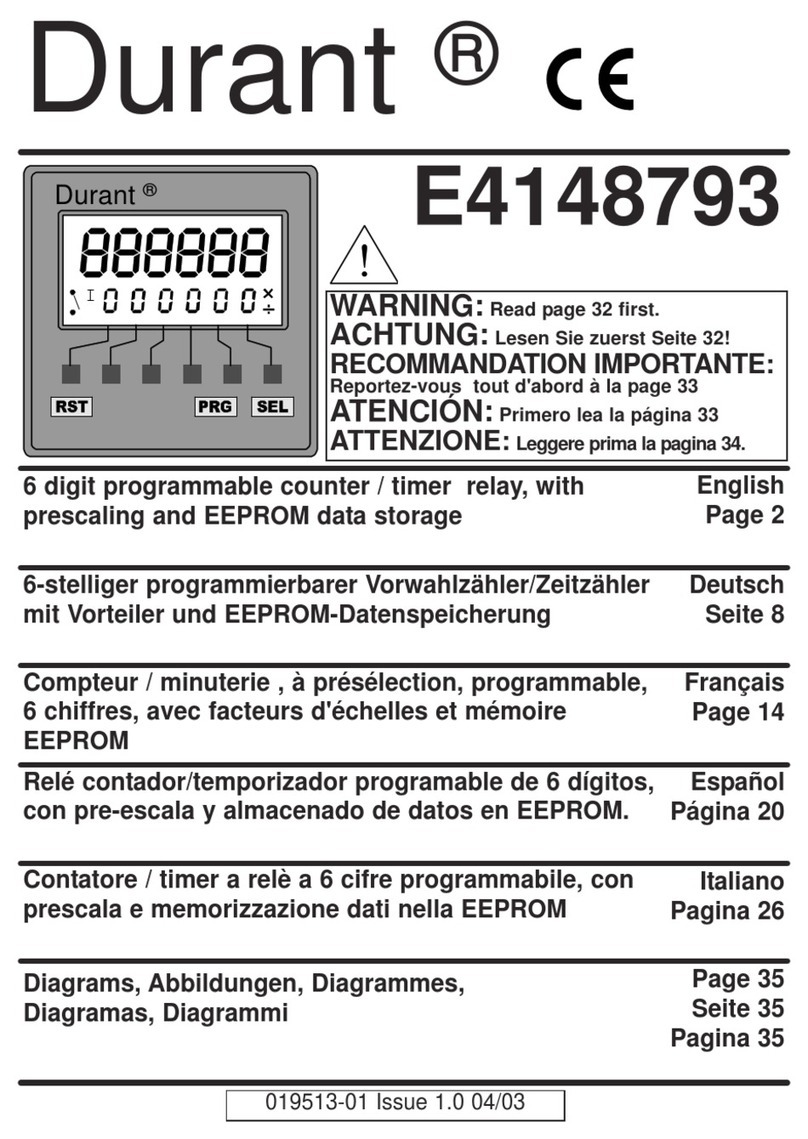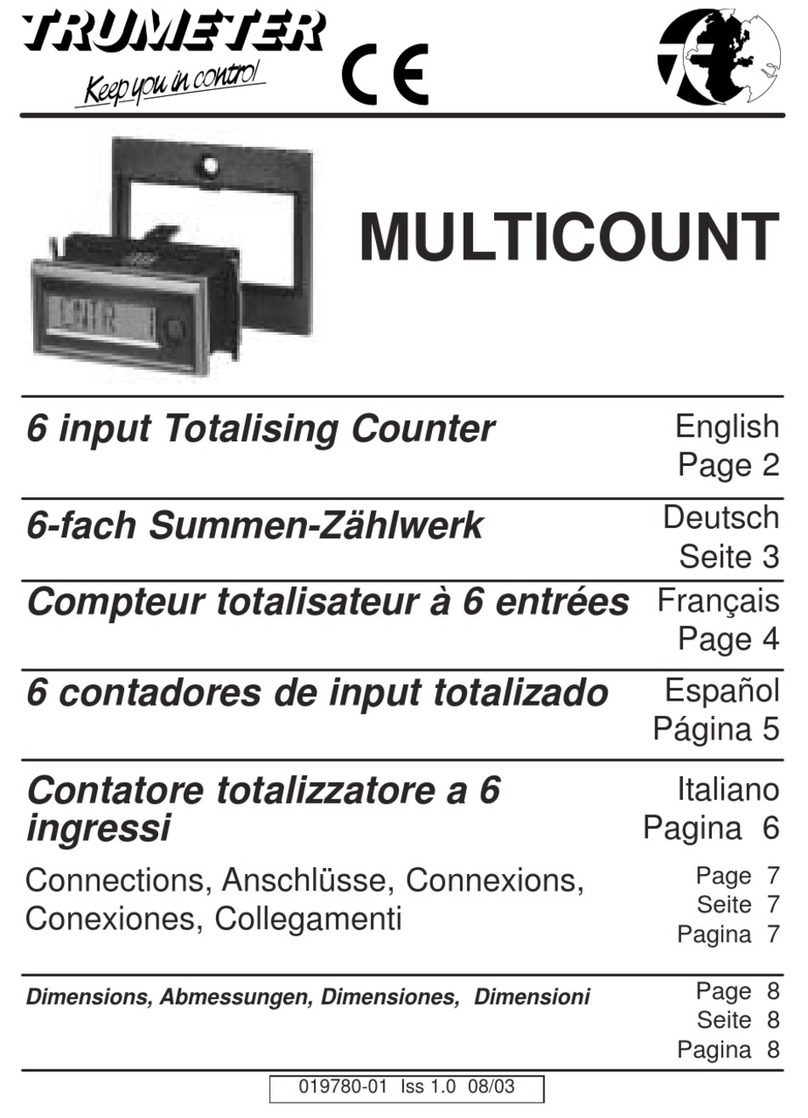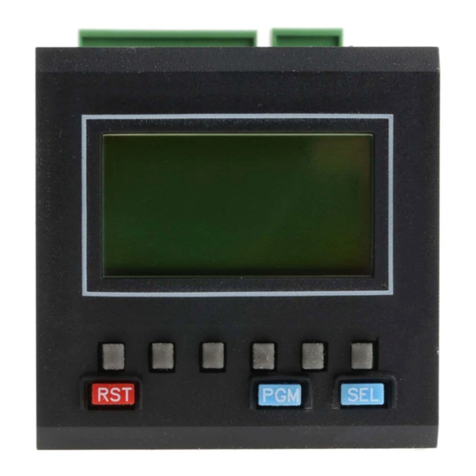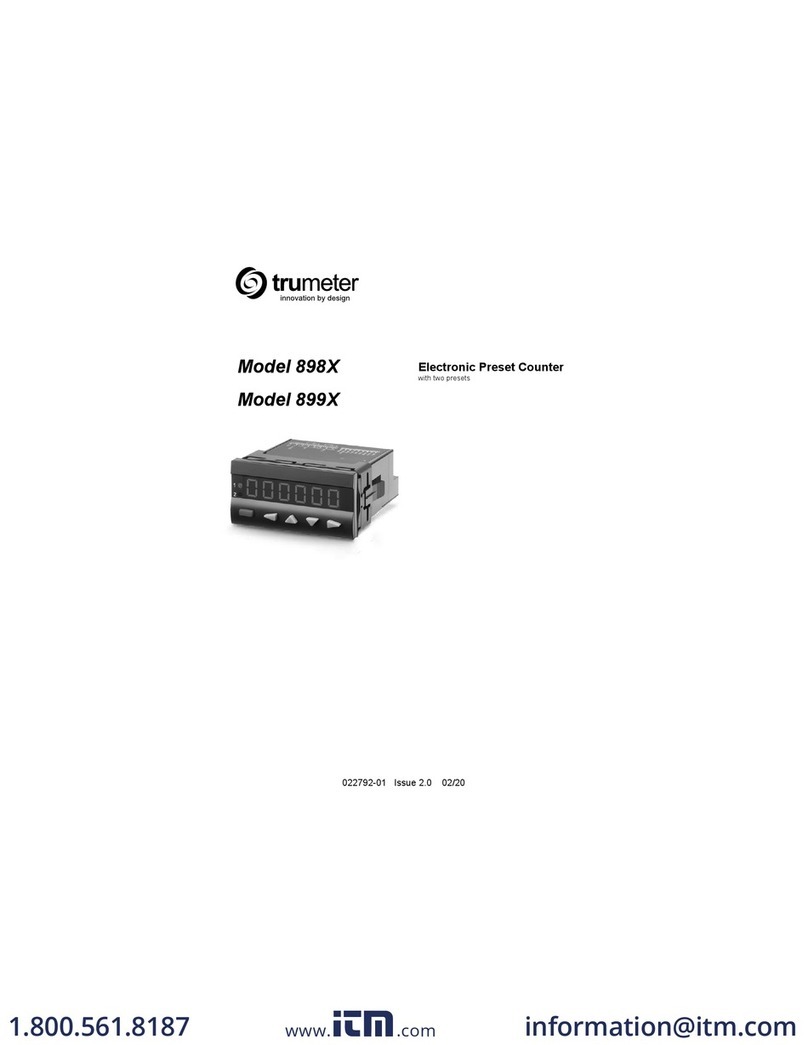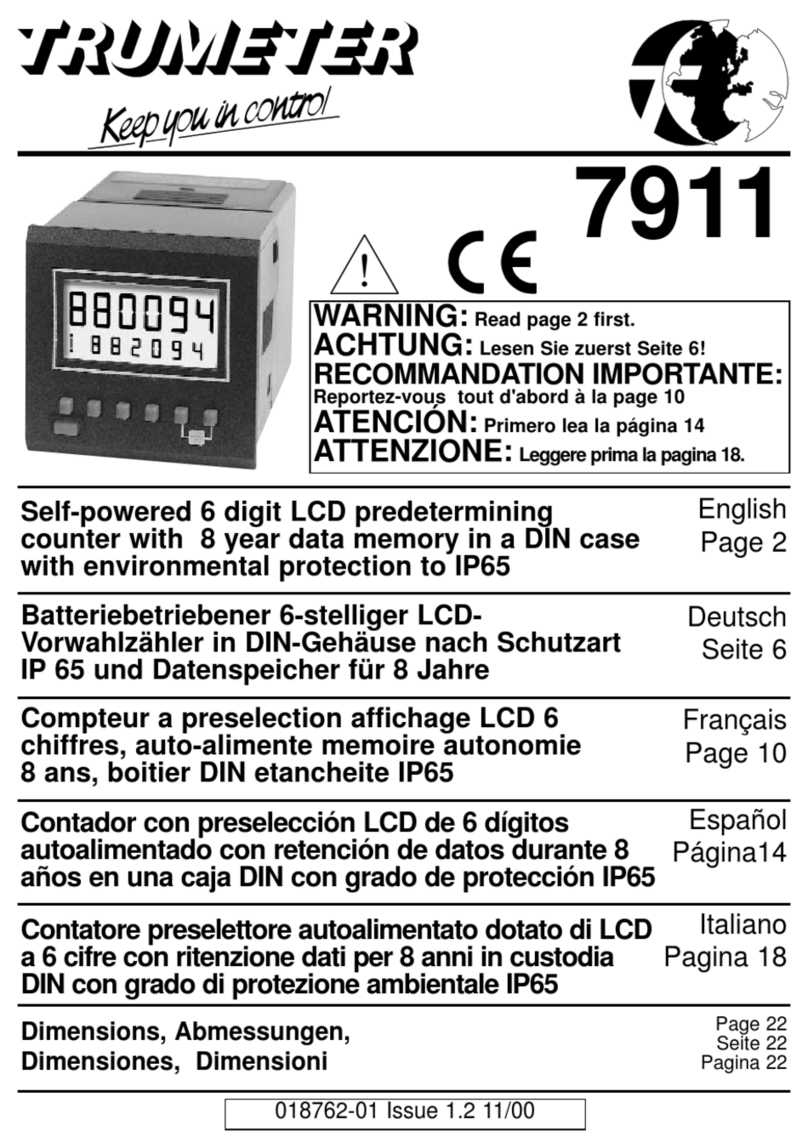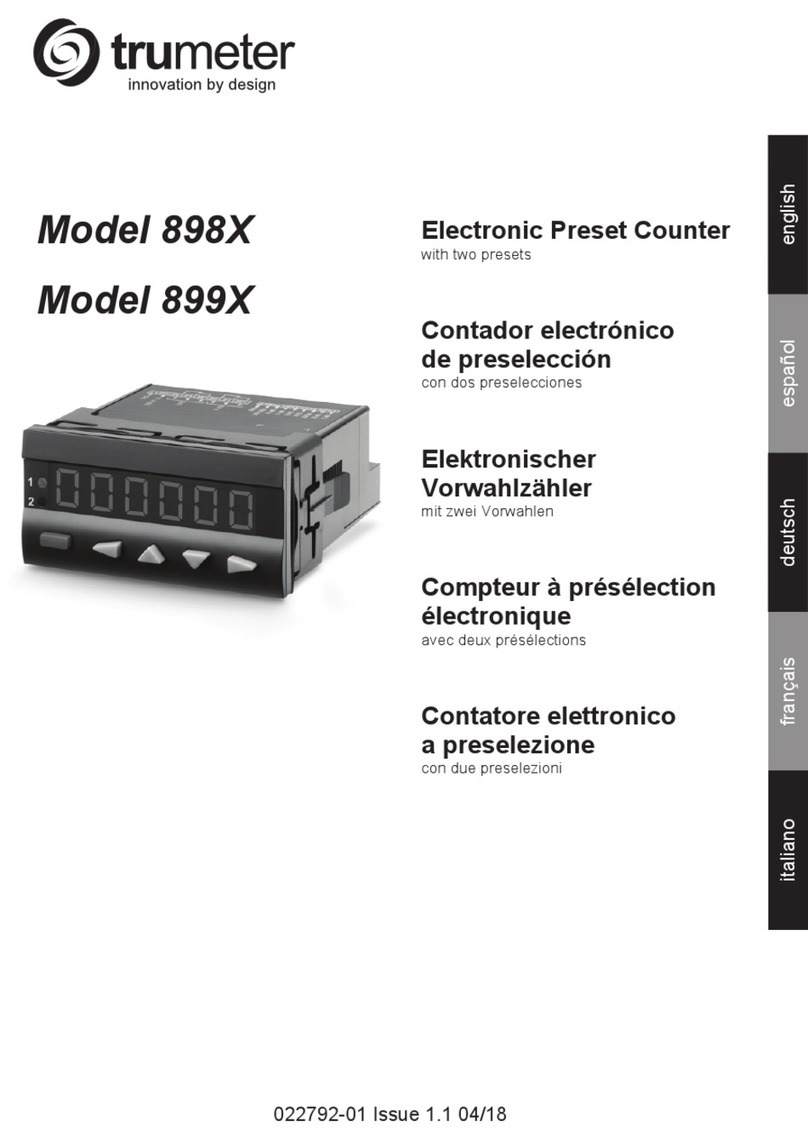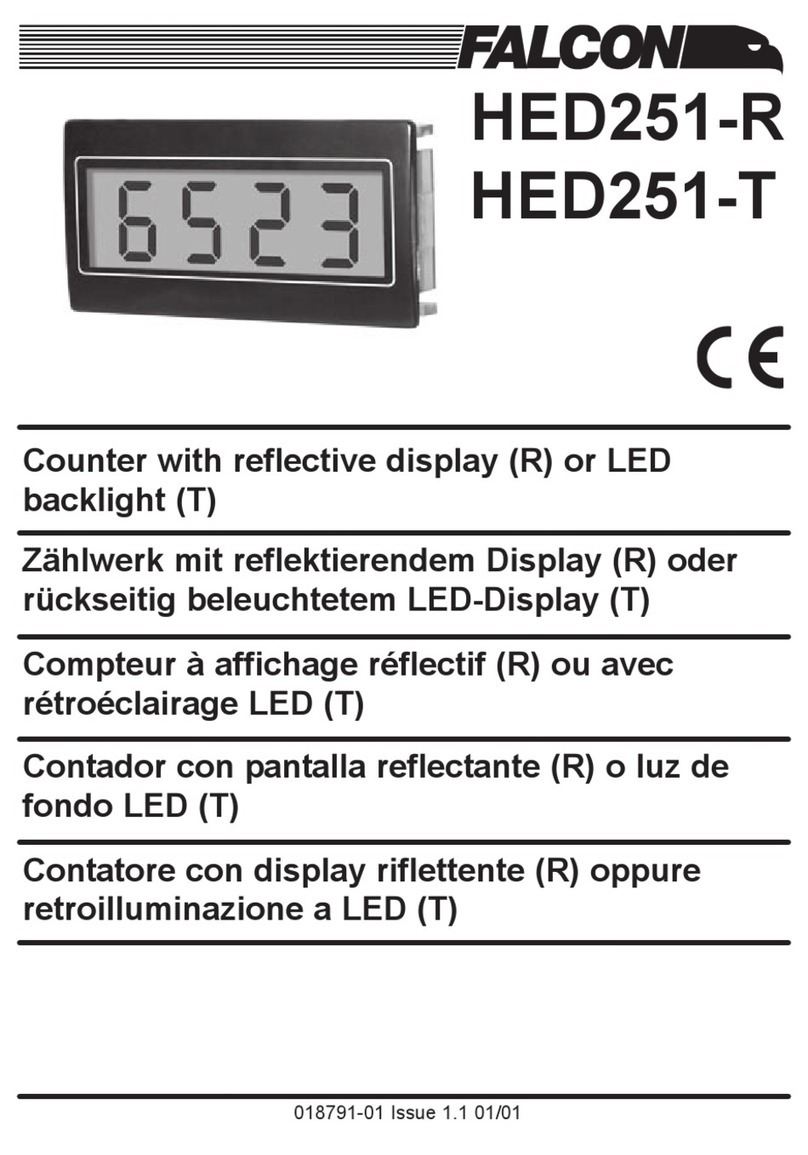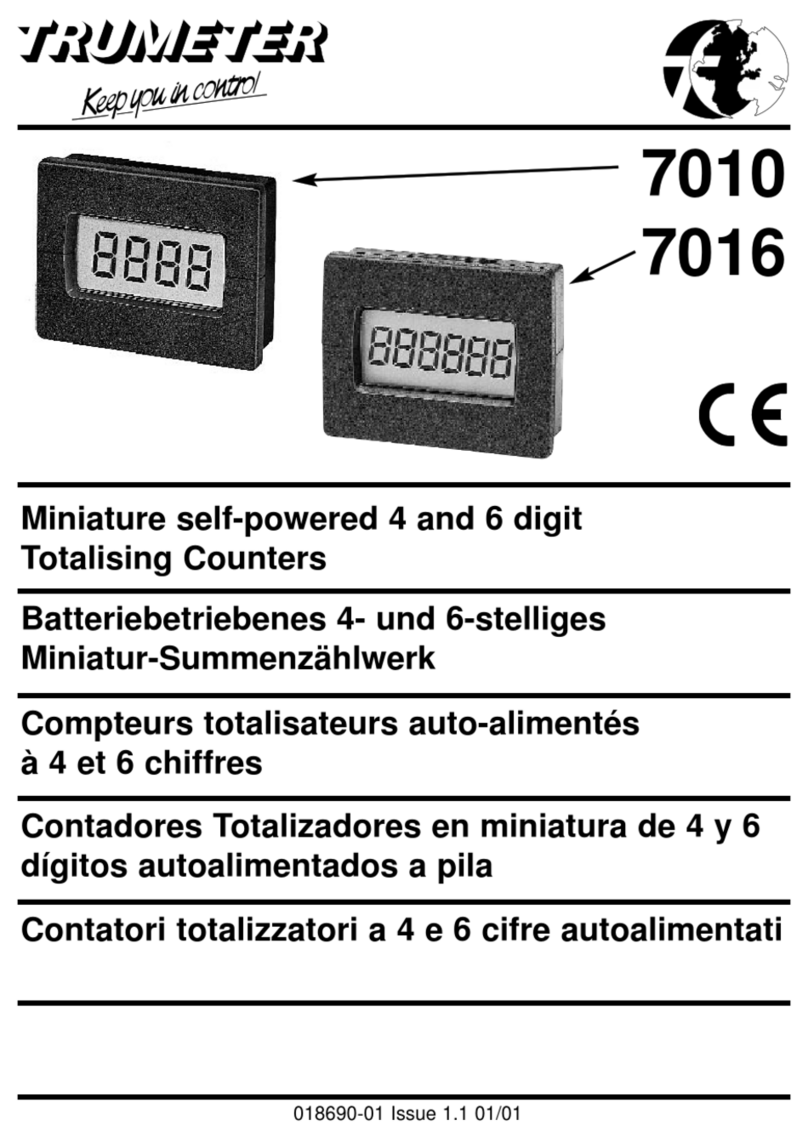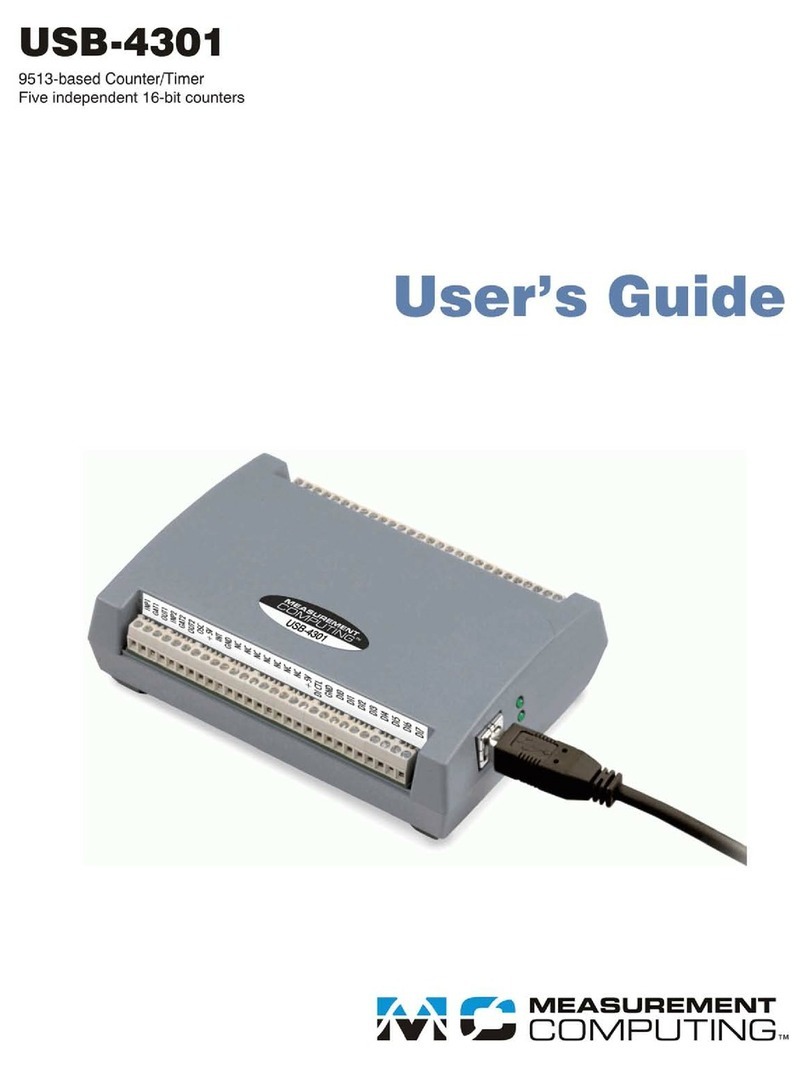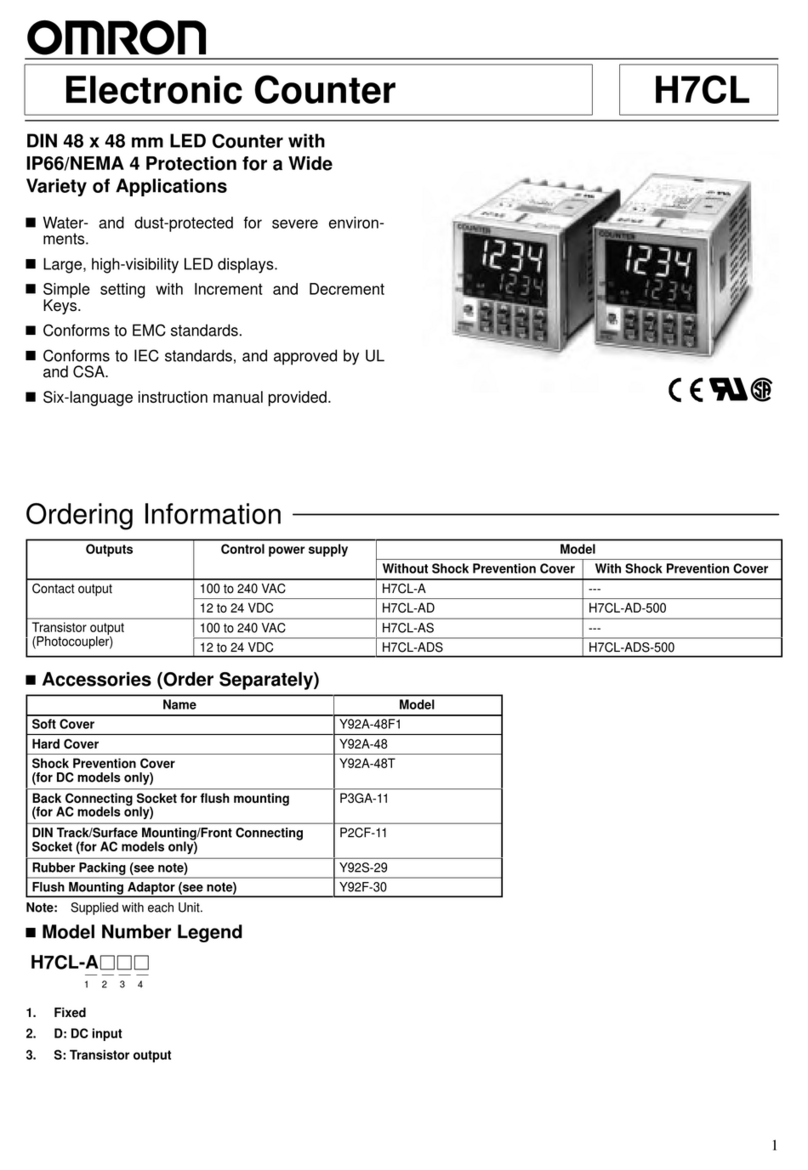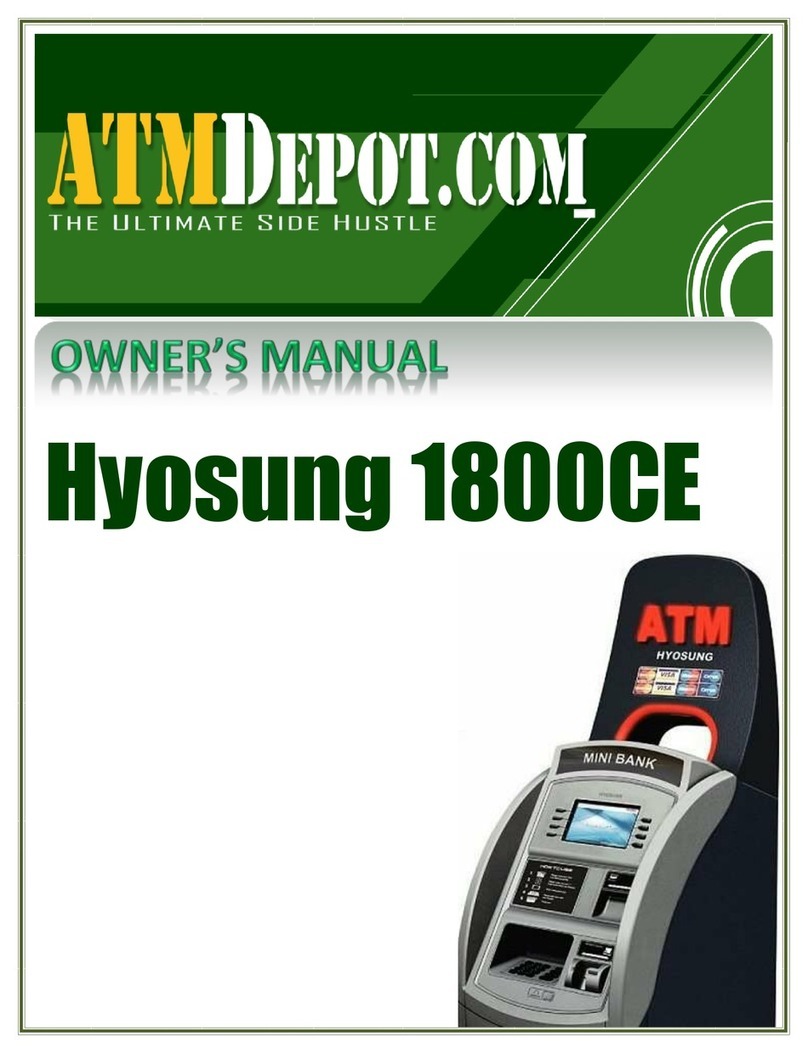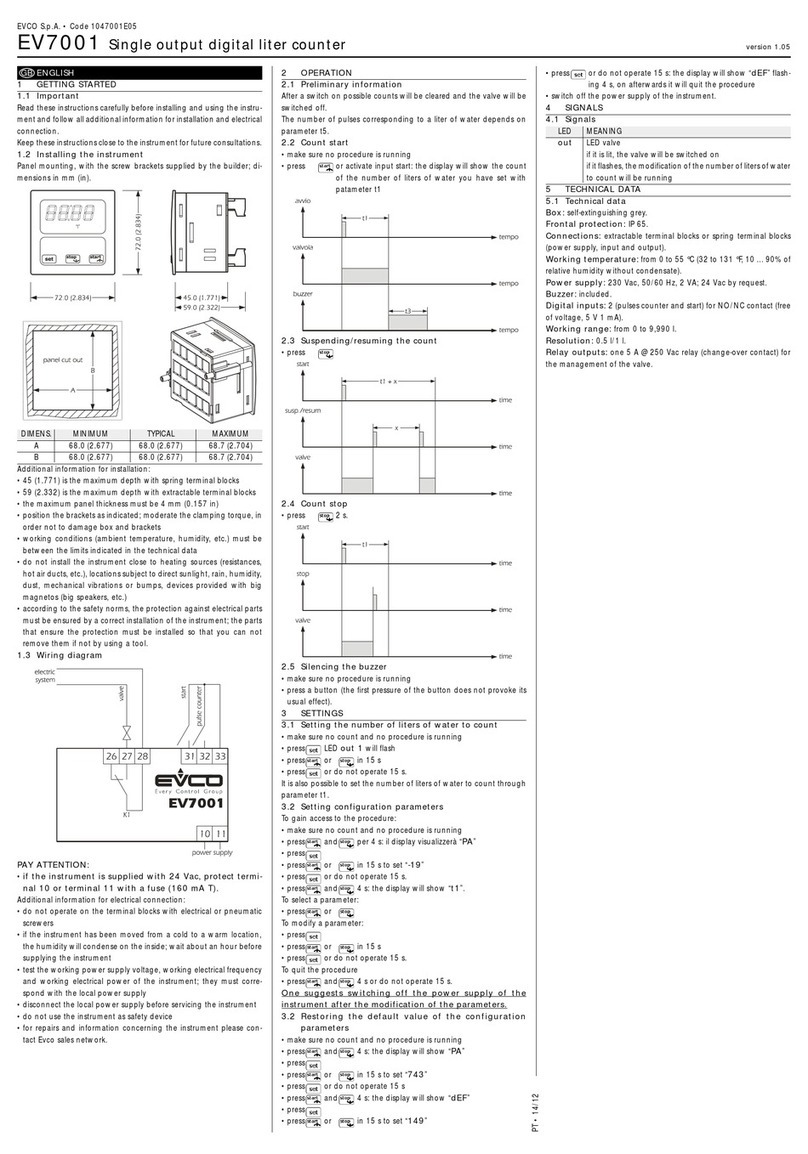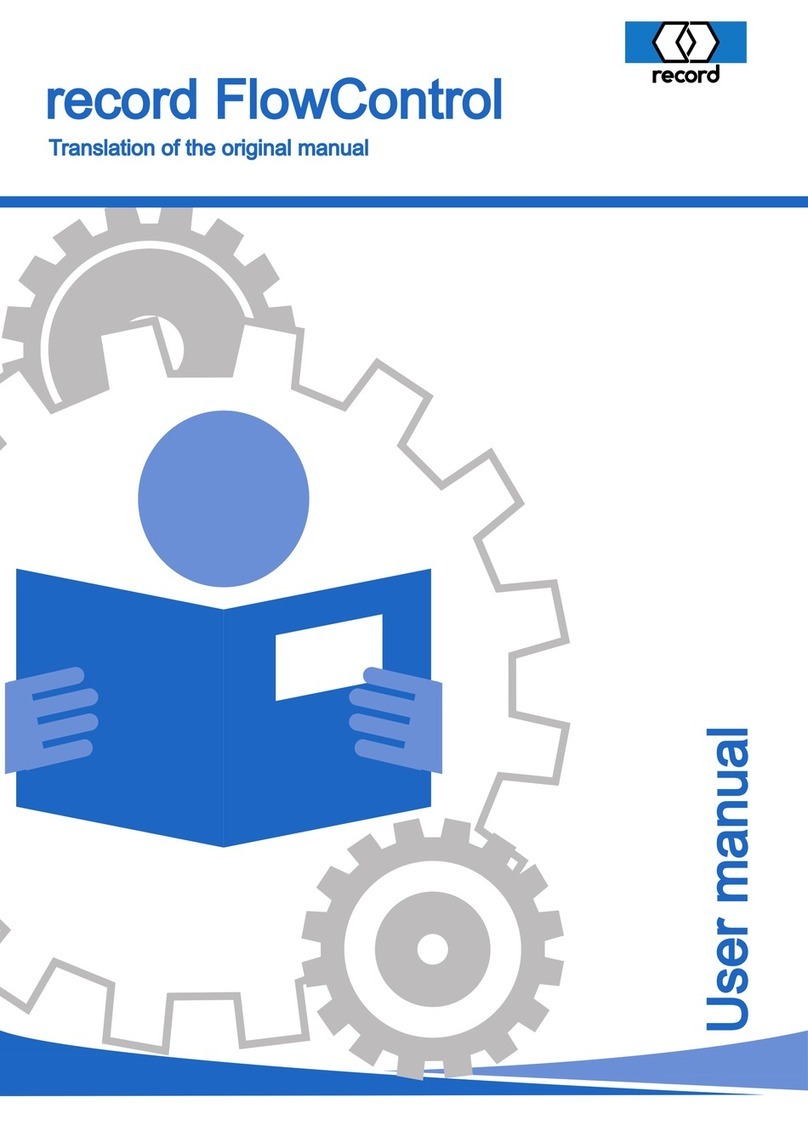2
OVERVIEW
The 9100 is a versatile multi-function counter/ratemeter and
process controller. Features include:-
• LCD three-row dot matrix display with backlight;
• simultaneous display of instantaneous, batch and total
counts;
• seven count modes;
BASIC OPERATION
Inputs A and B receive count pulses. The 9100 counts these
and also measures the rate at which the pulses are arriving
on input A only (input B in quadrature x 1 mode).
The progress of the count or the rate is shown on the front
panel display according to the mode and the scale values
you program into the unit.
Outputs R1, R2 and R3 change state when the count or the
rate becomes equal to a preset value (P1, P2 or P3) which
you set for each output. Each of the three outputs can be
programmed to respond either to a count value or a rate
value, as required. Each output can be independently
programmed to remain in the changed state for an amount
of time which you can set (the ‘on time’) - this is called
Pulsed Mode - or to remain in the changed state until the
end of a complete count cycle - this is called Latched Mode.
The normal sequence for outputs, in count mode, is for P1
and P2 to be set between zero and P3, since the value of
P3 determines the end of a cycle of counting; outputs 1 and
2 will therefore change state at preset points within the
count cycle. If you have chosen ‘automatic reset’ mode,
then reaching the end of a count cycle resets all latched
outputs to their initial state. If you have chosen ‘manual
reset’ mode, then latched outputs remain latched until the
counter is reset from the front panel or by a pulse on the
External Reset input.
Output 1 can alternatively be set up as a batch counter,
which you can preset to operate when a certain number of
count cycles have been completed.
Output 2 can alternatively be set up as a ‘motion monitor’.
In this mode, if no count pulse has been received for 12.8
seconds (equivalent to 4.7 rpm when using a shaft
encoder), then relay R2 operates to provide an indication
that the process has stopped. When the next pulse is
received, R2 releases and timing starts again.
• comprehensive prescaling for direct display in units of
your choice;
• three fully programmable relay outputs for process
control;
• simple, straightforward visual programming;
• programming in any of four European languages.
COUNT TYPES
UNI + DIR
Count is incremented or decremented by input A. Direction
is determined by input B:-
Input B open - Increment
Input B closed - Decrement
A+B
Count is incremented by either input A or input B.
A-B
Count is incremented by input A and decremented by B.
A/B
Count is incremented by input A. Display is derived from
input A divided by input B. Manual reset (keyboard or
remote) is required to clear the B count value.
Quadrature Counting Modes
For all quadrature modes, the phase of input A must lag or
lead that of input B by 90 degrees.
For an incrementing count, A must lead B by 90 degrees.
For a decrementing count, A must lag B by 90 degrees.
Quadrature x1
Count is incremented or decremented on the rising edge of
input B.
Quadrature x2
Count is incremented or decremented on the rising and
falling edges of input A.
Quadrature x4
Count is incremented or decremented on the rising and
falling edges of both inputs.
Note: In the quadrature counting modes, use electronic
sensors because inputs A and B are not debounced.
EXTERNAL CONNECTIONS
Two terminal blocks are provided at the back of the counter,
arranged as shown. The terminal strips may be unplugged
from the counter to facilitate easy wiring.
To ensure correct operation this unit must be installed in
accordance with the “Recommended Installation
Procedures for Micro-Processor Based Products” -
Trumeter product number 015580-01.
23456 7 89
1918
17
1615
14
13
1211
10
1
5
6
4
3
2
1
CN1
CN2
CN3
Connectors from rear
Connector CN1 Connector CN2
Connector CN3
1DC Output 12V
2DC Output 0V
3Signal Common
4Count Input A
5Count Input B
6External Reset
7Keyboard Disable
8Count Inhibit
9External Print
10 AC Mains L
11 AC Mains N
12 N.C.
13 Relay R1 Common
14 Relay R1 Contact
15 Relay R2 Common
16 Relay R2 Contact
17 Relay R3 Common
18 Relay R3 Contact
19 No Connection
1Receive (RX)
2Transmit (TX)
30V
4N.C.
5N.C.
6N.C.
Sink Mode Source Mode
1
2
3
4
5
6
7
8
9
Sensor 1
Sensor 2
+12v
0v
Signal (A)
(Sign al B)
External Reset
Keyboard Disable
Count Inhibit
External Print
Illustrating use of two sensors to provide
A and B signals (sink mode depicted).
1
3
4
5
6
7
8
9
Sensor
Signal (A)
(Sign al B)
+
v 0v
External Reset
Keyboard Disable
Count Inhibit
External Prin t
External Supply
10 to 30v dc
2
Illustrating use of external power supply
(source mode depicted).
+
1
2
3
4
5
6
7
8
9
Sensor
+12v
0v
Signal (A)
(Sign al B)
+
External Reset
Keyboard Disable
Count Inhibit
External Prin t
(NPN output devices)
1
2
3
4
5
6
7
8
9
+12v
0v
Signal (A)
(Sign al B)
External Reset
Keyboard Disable
Count Inhibit
External Print
Contact clos ure
device(s)
(Contact closure devices)
1
2
3
4
5
6
7
8
9
Sensor
+12v
0v
Signal (A)
(Sign al B)
External Reset
Keyboard Disable
Count Inhibit
External Print
(PNP output devices)
1
2
3
4
5
6
7
8
9
+12v
0v
Signal (A)
(Sign al B)
External Reset
Keyboard Disable
Count Inhibit
External Print
Contact closure
device(s)
(Contact closure devices)
3
CONNECTION OF SENSORS
A “sensor” can be a 3-wire proximity switch, 3-wire photocell
or incremental shaft encoder etc.
3-wire devices should use input A as the single input for
unidirectional counting.
For bi-directional (quadrature) counting, input A and input B
must be 90° out of phase, lag or lead.
Two 3-wire devices connected to inputs A and B
respectively can provide signals for bi-directional counting
(either for quadrature or A-B modes).
When signal is generated by contact closure devices,
choose “contact cls” in programming. This ensures
adequate de-bouncing but limits the count rate to 30 counts
per second.
The external control inputs are permanently set in de-
bounce mode but may also be driven by electronic devices,
subject to the 30 count per second limitation.
TIMING DIAGRAM
The timing diagram below illustrates how the direction of
count is controlled in quadrature mode by the lead or lag of
the pulses on Input A with respect to Input B.
A
B
Count up Count down
90º Lead 90º Lag
COMMUNICATIONS PORT (CN3)
RS232-C communication is used to allow connection of the 9100 to a printer. Printouts of the user text (12 characters) and
count or rate value plus engineering units may be initiated from the keyboard or external printer input.
Baud rate, number of stop bits and number of print copies are selected in program mode.
If the printer type is set to IBM/Epson, a PC can be used to remotely execute a Print or Reset:Connect the PC’s serial port
transmit pin to the 9100’s RJ11 receive pin, and send an ASCII P (50 Hex) to execute a Print or an ASCII R (52 Hex) to
execute a Reset.
The data may be read into a PC by connecting the RJ11 transmit pin to the PC’s serial port receive pin, instead of a printer.
In Manual Reset mode only, the 9100 can be automatically reset as soon as a Print is executed (by the keyboard or
externally). This feature can be turned on or off using the Comms/Print menu (see page 6).
Please note:
Any signal cables connected to this device must not exceed
30 metres in length.
If any signal cables are installed that are routed outside the
building, it will be necessary to install additional surge
protection devices.
www.GlobalTestSupply.com
Find Quality Products Online at: sales@GlobalTestSupply.com

